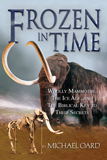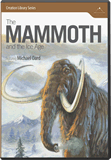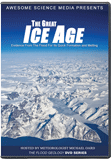
Chapter 10
The Ice Age
When we start our reasoning from the truth of Scripture, we can develop a model to help us understand the one and only Ice Age.
“Although theories abound, no one really knows what causes ice ages.”
—David Alt, Glacial Lake Missoula and its Humongous Floods (Missoula, Montana: Mountain Press Publishing Company, 2001), p. 180.
What You Will Learn
The idea of an ice age has sparked much controversy as well as much imagination. In the framework of an earth that is billions of years old, it is believed that there have been many ice ages. These are believed to have been of different length and intensity, with several covering the entire globe in a snowball earth scenario. How life was able to evolve during these periods is not understood, but there are many more problems for the long-age ideas of ice ages. The most significant problem is the explanation of a mechanism that could turn an ice age on and off. Using uniformitarian principles, there is no way to explain, in a consistent manner, how even a single ice age could occur, let alone many over millions of years.
When we start our reasoning from the truth of Scripture, we can develop a model to help us understand the one and only Ice Age. The account of the Flood in Genesis gives us a foundation for a model of this Ice Age. The two key elements for an ice age—a warm ocean and cool continents—are a natural consequence of the Flood, and only the Bible gives us a clear picture of how the Ice Age began and ended. The Bible also helps us to make sense of the presence of mammoths in Siberia and the movement of animals between continents by land bridges. Starting from Scripture, we can better understand the world around us.
What Your Textbook Says about the Ice Age
| Evolutionary Concept | Prentice Hall | Glencoe | Holt | Articles |
|---|---|---|---|---|
| Multiple ice ages have occurred over hundreds of millions of years and caused mass extinctions. | T186C | T165, T369, 370, 610–611, 649 | 334, 431, 433–434 | 7:9, 10:1, 10:3, 10:4, 10:5 |
| The last ice age began over 2 million years ago and ended about 10,000 years ago. | 188, 198 | T52C, T165, 165, T180D, 197–198, 369, 420, T525, 564, 635 | 429, 455, T643 | 10:1, 10:5 |
| The earth was once covered with ice, but most glaciers formed over thousands of years and left behind distinct features. | T186C–D, 188, T464 | 176, 592, 649 | 209, 257, 443 | 10:1, 10:2 |
| Evidence of past climates is recorded in the layers and air bubbles of ice deposits. | T186D | 198, 388 | 209, 434, 641 | 10:5 |
| Mammals evolved to be large and hairy to survive the last ice age. | T186C | 639–640, 566, 572 | — | 7:9, 10:1 |
| Land bridges allowed people and animals to move between the continents 20,000 years ago. | T186C, T586D | 424 | 455 | 10:4 |
What We Really Know about the Ice Age
Creation scientists and uniformitarian scientists agree that there is strong evidence for a period of extreme glaciation—an ice age—in the recent past. Just how recently is the point of dispute. From a uniformitarian perspective, the earth has experienced many ice ages. Some were so extensive that they almost covered the entire globe in a snowball earth scenario. What could have triggered and then ended these events is a mystery to scientists who insist on examining the past based on the processes seen operating in the present. In order to produce an ice age, two ingredients are required: an increase in evaporation causing more precipitation and cold continents on which the snow can accumulate over time. None of the uniformitarian scenarios can produce these conditions.
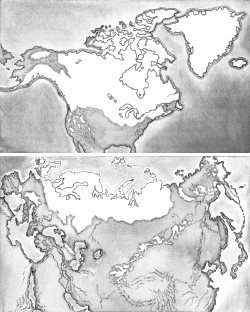
This map shows the extent of the ice sheets over North America during the Ice Age. Scientists who rely on evolutionary thinking believe this was the picture over 10,000 years ago. From a biblical perspective, scientists have suggested the Ice Age was a result of Noah’s Flood only a few thousand years ago.
There is no consensus in the secular scientific community as to what causes ice ages. The most popular models revolve around volcanic activity and the changing orbit of the earth around the sun, known as the Milankovitch mechanism. However, neither of these offers a satisfactory explanation. If volcanic activity increased, it would block the incoming light from the sun and cool the atmosphere. Cold air holds less moisture and the amount of precipitation would decrease and prohibit the formation of ice sheets. The Milankovitch mechanism suggests that the atmosphere cooled as the earth moves with respect to the sun in three ways. The earth’s orbit goes from a circle to an ellipse in 100,000 year cycles, the tilt of the axis changes over a 41,000 year cycle, and the axis wobbles on a 25,700 year cycle.
These changes are not likely to cause any significant change in the climate and still cannot account for the increased precipitation and the cooler continents. Because of the problems with each of the triggers, some scientists suggest that it was a complex interaction of several factors that led to the recurring ice ages. This makes the picture of the past even less clear, and it becomes more difficult to predict the future as well.
To support the multiple ice age theory, uniformitarian scientists have suggested that evidence from shelled organisms on the ocean floor matches the cycles predicted by the Milankovitch model. The direction of coiling changes when the organisms grow in water of different temperatures and the ratio of oxygen isotopes in the shells is supposed to indicate whether the shells grew during periods of glaciation. Because each of these methods starts with the assumption of long ages, they reinforce one another.
So, can the Bible give a clearer picture of the cause of the Ice Age? The answer centers on the Flood and the movement of the earth’s crust that accompanied it. As discussed earlier, the Flood likely involved much tectonic activity. This activity provides a mechanism that explains both of the requirements for an Ice Age. As the “fountains of the great deep” broke open, they released heated water and magma. This would have created jets of steam and the rain that accompanied the Flood. The temperature of the oceans would have increased, providing the energy to cause increased evaporation. The increase in evaporation would naturally lead to more precipitation over the continents.
The cooler climate can be explained by an increase in volcanic activity. The volcanism associated with the shifting crust would have released dust and aerosols into the atmosphere. These particles would stay suspended for many years and block the incoming sunlight. The reduced sunlight would cause cooler temperatures over the continents where the increased precipitation would fall as snow and accumulate to form ice sheets. Ice cores reveal volcanic activity extending through the last Ice Age.
With this model, there is a built-in off switch as well. Once the tectonic activity slows to approach the rates we see today, the debris settles out of the air, allowing the continents to gradually warm. The warm oceans continue to lose energy by evaporation until precipitation approaches current rates. This point marks the peak of the Ice Age. Michael Oard, a leading creation scientist with respect to study of the Ice Age, has developed a model that shows this all happening in a period of about 700 years after the Flood. His book Frozen in Time details many of the ideas summarized here and ideas found in other technical works regarding the Ice Age.
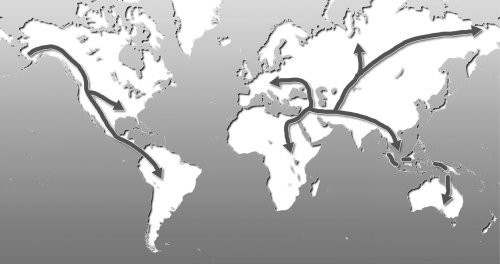
Lower sea levels created land bridges for animals to be able to migrate around the globe. The presence of fossil elephants and camels in the Americas can be explained as a result of the Ice Age.
So, starting from the Bible, we can develop a model that explains the onset and end of the Ice Age. But what about other aspects related to the Ice Age? There is evidence that suggests that climates in various regions around the world were much different during the time of the Ice Age than today. One such region is the Siberian plain. Today this area is frozen for most of the year with little vegetation. The Siberian tundra today would not support the antelope, beavers, woolly rhinoceros, and woolly mammoths that were present during the Ice Age. To support this large amount of wildlife, the area must have been a lush grassland. This is confirmed by the presence of grasses and flowers in the stomachs of mammoth carcasses—plants that do not grow there today. The area where the mammoths thrived was not covered by ice sheets and must have experienced relatively mild winters to support the diverse population now found as fossils.
The recolonization of animals and plants around the world after the Flood was also accomplished as a result of the Ice Age. As the water evaporated out of the warm oceans and became trapped on the continents as ice sheets, sea level dropped. This created land bridges in the Bering Strait, as well as other places around the globe, allowing animals and people to populate North America during the Ice Age. As the Ice Age ended, these areas filled with water again. Off the northern coast of Siberia, many mammoths were trapped on islands which eventually became their graveyard.
When we begin our attempt at understanding the Ice Age, the Bible gives us a firm foundation. Using the Flood as a part of the explanation, the Ice Age is no longer a mystery, but a natural consequence of the Flood and all of the events that accompanied it. Trying to understand how all of the evidence fits together in the absence of God’s Word has puzzled uniformitarian scientists. God has revealed much to us in the Bible, so beginning with that truth as a foundation gives us a much clearer picture than beginning with the reasoning of fallible humans.
Reference Article Summaries
10:1 Where does the Ice Age fit?
Oard, Where Does the Ice Age Fit?
The idea of an ice age is popular in films, but most people don’t look at this idea from a biblical perspective. Despite its popularity in secular circles, there is no good mechanism to explain how a single ice age could occur, let alone the many that have been proposed. The Bible offers a mechanism for the single Ice Age. An ice age is a time of extensive glacial activity, and the Ice Age was a result of the Genesis Flood. During this post-Flood Ice Age 30% of the land surface was covered with ice. We know the extent of the Ice Age by the physical evidence of moraines, scratched bedrock, and other markers that we see associated with glaciers today.

Scratched bedrock, like this specimen from the Athabasca Glacier in Canada, is evidence of glacial activity.
Uniformitarian scientists believe there have been thirty ice ages over the last several million years. Each ice age coincides with the cycling of earth’s orbital geometry. This astronomical explanation for the ice ages is called the Milankovitch mechanism (which has many scientific problems). Each of the last eight ice ages allegedly lasted about 100,000 years and those prior occurred about every 40,000 years. In the distant past, there are supposed to have been four ice ages that were nearly global in scope and lasted much longer. A mechanism that could cool surface temperatures and increase snowfall is absent from the secular models. There are many hypotheses, but no clear explanations.
Uniformitarian scientists reject the Genesis Flood and propose slow and gradual explanations for the volcanic and crustal movements that accompanied the Flood. A shroud of volcanic aerosols would have reflected sunlight back to space, causing cooler summers over land. The Bible tells us that “the fountains of the great deep” burst forth, releasing heated water and lava which added heat to the oceans. The warmer ocean would have increased evaporation and provided moisture to be dropped on the cold continents. This blend of cool continents and warm oceans is the ideal mechanism to create an ice age—a mechanism missing from the uniformitarian model. Using computer modeling, the ice sheets could have formed in less than 500 years.
Most creationists agree that there was one major Ice Age after the Flood. The timing of the Ice Age would have been controlled by the duration of the volcanism and warmer oceans. As the crust settled and the oceans cooled, the Ice Age would reach a maximum about 500 years after the Flood (based on standard heat budget equations), and then the ice sheets would melt over a 200 year period. This would produce catastrophic flooding on a regional scale. Based on biblical assumptions, the Ice Age lasted a total of 700 years—a timescale and mechanism arbitrarily rejected by uniformitarian scientists.
The theory of multiple ice ages is supposedly explained by ice sheets advancing and retreating in cycles during the Ice Age. These ice ages are also based on the assumptions of the Milankovitch mechanism. Ancient ice ages are claimed to have been recorded in the hard rock record, but there are substantial difficulties in interpreting these rocks as coming from ancient ice ages. From a biblical perspective, these can be explained as gigantic underwater landslides during the Flood.
The millions of woolly mammoth fossils found in North America and Siberia are a mystery to uniformitarian scientists. It is likely, from a biblical perspective, that the mammoths populated these areas after the Flood and were then buried during giant dust storms at the end of the Ice Age. The dust later froze, and the carcasses and bones became trapped in the permafrost.
Another aftereffect of the post-Flood Ice Age was the flooding from glacial Lake Missoula. An ice dam blocked the flow of water in northern Idaho, and a 2,000-foot-deep lake was formed in western Montana. When the dam failed, the water drained and scoured scablands and canyons in eastern Washington and Oregon. This idea was originally rejected by uniformitarian scientists, but is now accepted. This regional flood can help us understand more about the global Flood and the geologic features that are a result of the Flood and the Ice Age.
Uniformitarian scientists claim to be able to count annual layers in the Greenland ice sheet to determine its age in the same way people can count tree rings. In doing so, they arrive at 110,000 years near the bottom of the Greenland ice sheet. Similar claims for a much greater age are made for the Antarctica ice sheet. These claims are essentially based on the uniformitarian belief that the ice sheets are millions of years old. The data from ice cores can be better explained within the post-Flood Ice Age model, which dramatically reduces the calculated age to well within the biblical limit.
Ultimately, the Ice Age as a consequence of the Flood makes better sense of the evidence. From the ice sheet formation to the mammoth fossils and erosional features, starting with the Bible is the key to understanding the past.
10:2 “Snowball Earth”—a problem for the supposed origin of multicellular animals
Oard, 'Snowball Earth'—A Problem for the Supposed Origin of Multicellular Animals
Evolutionary scientists suggest that several ice ages that occurred hundreds of millions to billions of years ago actually extended to the equator—the “snowball earth” hypothesis. A major problem is that the snowball condition would be permanent unless there was some catastrophic event to reverse it. Evolutionists face a major problem. Life was supposed to be evolving into multicellular forms at this time—a difficult task in light of a global ice age. Rock formations also suggest very hot periods immediately after, and sometimes during, these ice ages.
To accommodate this, a freeze-fry model was created that allowed the rapid diversification of multicellular life. Volcanoes penetrated the ice and spewed carbon dioxide into the atmosphere, increasing temperatures via a greenhouse effect. A rapid reversal of temperature provided an opportunity for organisms to diversify. This happened five times in the evolutionary model. These cycles limit the likelihood of evolution occurring even further. There are many other significant problems with the model, and computer simulations have failed to show its viability. Trying to explain the explosion of life at the beginning of the Cambrian Period, while accommodating climate extremes, has proven an impossible puzzle for evolutionists to solve. Creationists can explain the rock evidence in terms of underwater landslides and rock formation during the hot-ocean phase of the Genesis Flood. The abrupt appearance of multicellular organisms is also easily accounted for by their creation and subsequent rapid burial early in the Flood.
10:3 The extinction wars
Oard, The Extinction Wars
Some evolutionists believe that at least 30 major ice ages have occurred over earth’s history. Most creationists hold to the view that there was a single ice age in the recent past. Evolutionists attempt to show how mass extinctions occurred on a global scale following the last (or first and only) ice age. The explanations include extinction by climate change, extinction by overhunting, or extinction by diseases introduced by humans and their domestic animals. Each of these hypotheses has major problems, and scientists from around the world have been unable to agree on this issue, even after over 100 years of study.
Details within a post-Flood Ice Age model seem to explain the evidence the best, but the Bible is the foundation for such thinking. Therefore, evolutionists must reject the clearest of the interpretations. The problems with the evolutionary model lie in the fact that its basic assumptions do not line up with the true history of the earth described in the Bible.
10:4 How did animals spread all over the world from where the Ark landed?
Taylor, How Did Animals Spread All Over the World from Where the Ark Landed?
Opponents often criticize biblical creationists by suggesting that the worldwide distribution of animals cannot be explained by the Bible. To the contrary, starting from the Bible we can build a model to explain the distribution. From Genesis 6:19–20 we know that representatives of all the kinds of air-breathing land animals and birds were on the Ark. For example, there would not have been two tigers and two lions, but two members of the cat kind from which lions, tigers and other members of the cat kind have developed. These animals were brought to Noah by divine intervention so that the recolonization after the Flood was not left to chance.
We also know from Scripture that the Ark landed in the mountains of Ararat, somewhere in modern eastern Turkey or western Iran. In Genesis 8:15–19 God instructed Noah to bring the animals off the Ark “so that they may abound on the earth, and be fruitful and multiply on the earth.” Recolonizing the earth was God’s will for the animals.
We can build a model based on these principles. Even if further discoveries were to discredit this model, they would not discredit Scripture. Using the dog kind as an example within the model, we can look at the recolonization. Within a short time period, there would have been many dogs of all different shapes and sizes. These would have begun to spread out and populate new areas, but they were all still dogs. Animals could have crossed oceans or bodies of water on floating log mats, or on land bridges exposed as water evaporated form the oceans during the Ice Age.
Another interesting feature is the association of warm and cold climate animals found as fossils in the same areas in post-Flood sediments. Evolutionists would not expect to find hippos with reindeer, but this can be explained in the biblical model. As these animals were populating new areas with changing climates, some were better able to survive, while others moved to areas where the climate was more suitable for them. Certain populations were better able to survive and colonize certain areas—all within the context of the biblical account of the Flood. Starting from Scripture, we can develop a model that makes sense of the physical evidence that we find across the globe.
10:5 Do ice cores show many thousands of years?
Oard, Do Ice Cores Show Many Tens of Thousands of Years?
Uniformitarian scientists claim that there are 110,000 years recorded in the Greenland ice sheet. The annual layers are clear at the top but become more difficult to define deeper in the ice sheet. The age interpretation is primarily based on the assumption that the ice sheets have existed for millions of years. Slow accumulation over time would allow the lower layers to be compressed to paper–thin layers near the bottom. If the ice built up rapidly, as explained by the creationist Ice Age model, the annual layers would be thick at the bottom, with some compression, and thin toward the top.
Oxygen isotopes are used to determine an “annual signature” for each layer, but the thickness of each layer must be assumed to take the measurements in the correct places. Within the creationist model for the formation of the ice sheets, what is actually being measured is multiple samples within the same year. The layering can instead be explained as storm cycles that mimic annual cycles, and the number of annual layers becomes greatly exaggerated. Likewise, the age of the Antarctic ice sheet is assumed to be 700,000 years old near the bottom. To arrive at this date, an astronomical mechanism for the ice age is assumed to have caused ice ages every 100,000 years. Counting what are assumed to be seven cycles in the ice cores and multiplying by the assumed 100,000 year cycle, a date of 700,000 years is determined.
From the biblical creationist perspective, the Greenland and Antarctic ice sheets are remnants of the Ice Age that followed the Genesis Flood. These ice sheets would have been built up through the Ice Age, which ended about 3,500 years ago, and then slowed as the oceans continued to cool. As evidence of the possibility of rapid growth of the sheets, eight World War II planes were abandoned in Greenland in 1942 and were found in 260 feet of ice in the late 1980s.
The ice cores also show dramatic swings in temperature within very short periods of time, assuming the uniformitarian model is true. This would suggest that dramatic climate changes can occur in decades and fuels the fears of such changes today. If the annual layers are much thicker, these differences would represent annual changes or longer-term changes due to volcanic activity. Again, the Bible offers a clearer way to interpret the evidence.
Questions to Consider
- What mechanism is used to explain how ice ages begin and end? Have these mechanisms been observed or tested?
- How are intact mammoth carcasses encased in permafrost explained by scientists?
- Is the measuring of ice core “dates” an invalid circular argument since the deeper layers are assumed to be many thousands of years older and therefore thinner, which then supports the idea that they are older?
Tools for Digging Deeper
Footprints in the Ash by John Morris and Steve Austin
Frozen in Time by Mike Oard
An Ice Age Caused by the Genesis Flood by Mike Oard
The New Answers Book 1 by Ken Ham et al.
Evolution Exposed: Earth Science
Learn how to respectfully counter the evolutionary bias and indoctrination in astronomical and geological evolution.
Read Online Buy BookRecommended Resources

Answers in Genesis is an apologetics ministry, dedicated to helping Christians defend their faith and proclaim the good news of Jesus Christ.
- Customer Service 800.778.3390
- © 2024 Answers in Genesis


